| Article ID | Journal | Published Year | Pages | File Type |
|---|---|---|---|---|
| 2016452 | Plant Physiology and Biochemistry | 2010 | 6 Pages |
Antioxidative responses of Elodea nuttallii (Planch.) H. St. John to short-term iron exposure were investigated in the study. Results showed that iron accumulation in E. nuttallii was concentration dependent. Growth of E. nuttallii was promoted by low iron concentration (1–10 mg L−1 [Fe3+]), but growth inhibition was observed when iron concentration beyond 10 mg L−1. The synthesis of protein and pigments increased within 1–10 mg L−1 [Fe3+] range. The activities of superoxide dismutase (SOD), catalase (CAT), peroxidase (POD) and glutathione-S-transferase (GST) were up to maximal values at 10 mg L−1 [Fe3+]. High iron concentration inhibited the synthesis of protein and pigments as well as activities of antioxidative enzymes, and accelerated degradation of pigment and production of ROS. Low iron concentration had no significant influences on PSII maximal quantum yield, activity of PSII and relative electron transport rate though PSII. Malondialdehyde (MDA) and proline concentrations were highest at 100 and 1 mg L−1 [Fe3+], respectively.
Research highlights► Iron accumulation in E. nuttallii was concentration dependent. ► Excess iron inhibited the growth and activities of antioxidative enzymes. ► Excess iron inhibited the synthesis of protein and pigments of E. nuttallii. ► Low iron had no significant influence on leaf chlorophyll fluorescence. ► MDA and proline concentrations were highest at 100 and 1 mg L−1 [Fe3+], respectively
